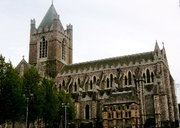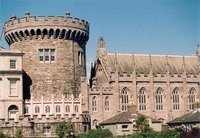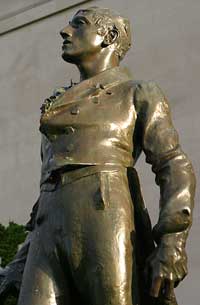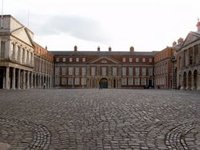History of Dublin
|
|
The City of Dublin can trace its origin back 2000 years, and for much of this time it has been Ireland's capital and center of culture, education and industry. During this time it has stood witness to famine, peace, social change, war which have effected Ireland.
| Contents |
|
1 Medieval Dublin |
Founding and early history
Irish_fifty_pence_(decimal_coin_for_millennium).png
The earliest reference to Dublin appears in the writings of Claudius Ptolemaeus (Ptolemy), the Greek astronomer and cartographer, around the year A.D. 140, who calls it Eblana Civitas. This would seem to give Dublin a just claim to nearly two thousand years of antiquity, as the settlement must have existed a considerable time before Ptolemy became aware of it.
Beginning in the 10th century, there were two settlements where the modern city stands. The Viking settlement was known as An Dubh Linn (or Black Pool, referring to a black pool of water) (It was called Dyflin by the Vikings), which was located in the area now known as Wood Quay, and a Celtic settlement, Áth Cliath ("hurdle ford") further up river. The Celtic settlement's name is used as the Irish language name of the city, while the modern English name came from the Viking settlement. The Vikings, or Ostmen as they called themselves, ruled Dublin for almost three centuries, notwithstanding their defeat by the Irish High King Brian Boru at the battle of Clontarf in 1014. See Also The Kings of Dublin.
Dublin became the centre of English power in Ireland after the 12th century Norman conquest of the southern half of Ireland (Munster and Leinster), replacing Tara in Meath -- seat of the Gaelic High Kings of Ireland -- as the focal point of Ireland's polity. Over time, however, many of the Anglo-Norman conquerors were absorbed into the Irish culture, adopting the Irish language and customs, leaving only a small area around Dublin, known as the Pale, under direct English control. People outside this area were still considered savage, giving rise to the expression "Beyond the Pale".
Medieval Dublin
After the Anglo-Norman taking of Dublin in 1171, many of the city’s Norse inhabitants left the old city, which was on the south side of the river Liffey and built their own settlement on the north side, known as Ostmantown or "Oxmantown". Dublin became the capital of the English Lordship of Ireland from 1171 onwards and was peopled extensively with settlers from England and Wales. The rural area around the city, as far north as Drogheda, also saw extensive English settlement. In the 14th century, this area was fortified against the increasingly assertive Native Irish – becoming known as the Pale. In Dublin itself, English rule was centred on Dublin Castle. The city was also the seat of the Parliament of Ireland, which was composed of representatives of the English community in Ireland. Important buildings that remain from this time include St Patrick's Cathedral, Christchurch Cathedral and St Audoen's Church, all of which are within a kilometre of each other. The last surviving section of Dublin's medieval walls overlook St Audoen's onto Cook St.
The inhabitants of the Pale developed an identity familiar from other settler-colonists of a beleaguered enclave of civilisation surrounded by barbarous natives. The siege mentality of medieval Dubliners is best illustrated by their annual pilgrimage to Cullen’s field in Ranelagh, where in 1209, 500 recent settlers from Bristol had been massacred by the O’Toole clan during a fair. Every year on "Black Monday", the Dublin citizens would march out of the city to the spot where the atrocity had happened and raise a black banner in the direction of the mountains to challenge the Irish to battle in a gesture of symbolic defiance. This was still so dangerous until the 17th century that the participants had to be guarded by the city militia and a stockade against, "the mountain enemy".
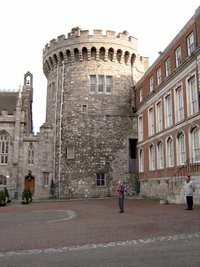
Medieval Dublin was a tightly knit place of around 5-10,000- people, intimate enough for every newly married citizen to be escorted by the mayor to the city bullring to kiss the enclosure for good luck. It was also very small in area, an enclave hugging the south side of the Liffey of no more than three square kilometres. Outside the city walls were suburbs such as the Liberties, on the lands of the Archbishop of Dublin, and Irishtown, where Gaelic Irish were supposed to live, having been expelled from the city proper by a 15th century law. Although the native Irish were not supposed to live in the city and its environs, many did so and by the 16th century, English accounts complain that Irish Gaelic was starting to rival English as the everyday language of the Pale.
Life in Medieval Dublin was very precarious. In 1348, the city was hit by the Black Death – a lethal bubonic plague that ravaged Europe in the mid-14th century. In Dublin, victims of the disease were buried in mass graves in an area still known as "Blackpitts". The plague recurred regularly in city until its last major outbreak in1649. The city was also the scene of constant warfare, both endemic low level violence and as a battleground in major wars. Throughout the middle ages, it paid protection money or "black rent" to the neighbouring Irish clans to avoid their predatory raids. In 1314, an invading Scottish army burned the city’s suburbs. As English interest in maintaining their Irish colony waned, the defence of Dublin from the surrounding Irish was left to the Fitzgerald Earls of Kildare, who dominated Irish politics until the 16th century. However, this dynasty often pursued their own agenda. In 1487, during the English Wars of the Roses, the Fitzgeralds occupied the city with the aid of troops from Burgundy and proclaimed the Yorkist Lambert Simnel to be King of England. In 1536, the same dynasty, led by Silken Thomas, who was angry at the imprisonment of Garret Fitzgerald, Earl of Kildare, besieged Dublin Castle. Henry VIII sent a large army to destroy the Fitzgeralds and replace them with English administrators. This was the beginning of a much closer, though not always happy, relationship between Dublin and the English Crown.
Colonial Dublin
Dublin and its inhabitants were transformed by the upheavals of the 16th and 17th centuries in Ireland. These saw the first thorough English conquest of the whole island under the Tudor dynasty. While the Old English community of Dublin and the Pale were happy with the conquest and disarmament of the native Irish, they were deeply alienated by the Protestant reformation that had taken place in England, being all almost all Roman Catholics. In addition, they were angered by being forced to pay for the English garrisons of the country through an extra-parliamentary tax known as "cess". Several Dubliners were executed for taking part in the Desmond Rebellions in the 1580s. Their discontent was deepened by the events of the Nine Years War of the 1590s, when English soldiers were required by decree to be housed by the townsmen of Dublin and they spread disease and forced up the price of food. The wounded lay in stalls in the streets, in the absence of a proper hospital. In 1597, the English gunpowder store in Winetavern Street exploded, killing nearly 200 Dubliners. In 1595, Elizabeth I opened Trinity College Dublin (located at that time outside the city on its eastern side) as a Protestant University for the Irish gentry. However, the important Dublin families spurned it and sent their sons instead to Catholic Universities on continental Europe. As a result of these tensions, the English authorities came to see Dubliners as unreliable and encouraged the settlement there of Protestants from England. These "New English" became the basis of the English administration in Ireland until the 19th century. Protestants became a majority in Dublin in the 1640s, when thousands of them fled there to escape the Irish Rebellion of 1641. When the city was subsequently threatened by Irish Catholic forces, the Catholic Dubliners were expelled from the city by its English garrison.In the 1640s, the city was besieged twice during the Irish Confederate Wars, in 1646 and 1649. However on both occasions the attackers were driven off before a lengthy siege could develop. In 1649, on the second of these occasions, a mixed force of Irish Confederates and English Royalists were routed by Dublin's English Parliamentarian garrison in the battle of Rathmines, fought on the city's southern outskirts. In 1650s after the Cromwellian conquest of Ireland, Catholics were banned from dwelling within the city limits under the vengeful Cromwellian settlement but this law was not strictly enforced. Ironically, this religious discrimination led to the Old English community abandoning their English roots and coming to see themselves as part of the native Irish community. By the end of the seventeenth century, Dublin was the capital of the Kingdom of Ireland – ruled by the Protestant New English minority but also larger, more peaceful and prosperous than at any time in its previous history.
From a Medieval to a Georgian City
See Also Georgian Dublin
Pcourtfdoor.jpg
In the 1980s it was sensitively turned
into a shopping centre
Powerscourt Georgian ceiling
interior Georgian door
By the beginning of the 18th century the English had established control and imposed the harsh Penal Laws on the Catholic majority of Ireland's population. In Dublin however the Protestant ascendancy was thriving, and the city expanded rapidly from the 17th century onward. By 1700, the population had surpassed 60,000, making it the second largest city after London in the British Empire. Under the Restoration, Ormonde, the then Lord Deputy of Ireland made the first step toward modernising Dublin by ordering the houses along the river Liffey had to face the river and have high quality frontages. This was in contrast to the earlier period, when Dublin faced away from the river, often using it as a rubbish dump.
Dublin started the 18th century as, in terms of street layout, a medieval city akin to Paris. In the course of the eighteenth century (as Paris would in the nineteenth century) it underwent a major rebuilding, with the Wide Streets Commission demolishing many of the narrow medieval streets and replacing them with large Georgian streets. Among the famous streets to appear following this redesign were Sackville Street (now called O'Connell Street), Dame Street, Westmoreland Street and D'Olier Street, all built following the demolition of narrow medieval streets and their amalgamation. Five major Georgian squares were also laid out; Rutland Square (now called Parnell Square) and Mountjoy Square on the northside, and Merrion Square, Fitzwilliam Square and Saint Stephen's Green, all on the south of the River Liffey. Though initially the most prosperous residences of peers were located on the northside, in places like Henrietta Street and Rutland Square, the decision of the Earl of Kildare (Ireland's premier peer, later made Duke of Leinster), to build his new townhouse, Kildare House (later renamed Leinster House after he was made Duke of Leinster) on the southside, led to a rush from peers to build new houses on the southside, in or around the three major southern squares. The massive northside houses ending up becoming tenements, into which large numbers of poor people moved, often being exploited by landlords, who packed in entire families into each large Georgian room. Only the area of the old city named Temple Bar (located between Dame Street and the river Liffey) and the area around Grafton street survived with their narrow medieval street pattern intact.
For all its Enlightenment sophistication in fields such as architecture and music (Handel's Messiah was first performed there in Fishamble street), 18th century Dublin remained decidedly rough around the edges. Its slum population rapidly increased - fed by the mounting rural migration to the city - housed mostly in the north and south-west quarters of the city. Rival gangs known as the "Liberty Boys" -mostly weavers from the Liberties - and the "Ormonde Boys" - butchers from Ormonde quay on the northside - fought bloody street battles with each other, sometimes heavily armed and with numerous fatalities. Its was also common for the Dublin crowds to hold violent demonstrations outside the Irish Parliament when the members passed unpopular laws. One of the effects of continued rural migration to Dublin was that its demographic balance was again altered, Irish Catholics becoming the majority in the city again in the late 18th century.
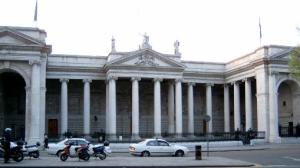
The old Irish Houses of Parliament
Built in the 1720s, the building served as the seat of The House of Commons and House of Lords until 1800. It is now a branch of the Bank of Ireland.
Rebellion, Union and Catholic Emancipation
Until 1800 the city housed an independent (though still exclusively Anglican) Irish Parliament, and as mentioned it was during this period that much of the great Georgian buildings of Dublin were built. By the late 18th century, Irish Protestants - the descendants of British settlers - had come to see Ireland as their native country, and the Irish Parliament successfully agitated for increased autonomy and better terms of trade. However, under the influence of the American and French revolutions, some Irish radicals went a step further and formed the United Irishmen to create a non-sectarian democratic republic. United Irish leaders in Dublin included Napper Tandy, Oliver Bond and Edward Fitzgerald. Wolfe Tone, the leader of the movement, was also from Dublin. The United Irishmen planned to take Dublin in street rising in 1798, but their leaders were arrested and the city occupied by a large British military presence. There was some local fighting in the city's outskirts - such as Rathfarnham, but the city itself remained firmly under control during the Irish Rebellion of 1798. The Protestant Ascendancy was shocked by the events of the 1790s, as was the British government. In response to them, in 1801 under the Irish Act of Union, which merged the Kingdom of Ireland with the Kingdom of Great Britain to form the United Kingdom of Great Britain and Ireland the Irish Parliament voted itself out of existence and Dublin lost much of its political influence. Though the city's growth continued, it suffered financially from the loss of parliament and more directly from the loss of the income that would come with the arrival of hundreds of peers and MPs and thousands of servants to the capital for sessions of parliament and the social season of the viceregal court in Dublin Castle. Within a short few years, many of the finest mansions, including Leinster House, Powerscourt House and Aldborough House, once owned by peers who spent much of their year in the capital, were for sale. Many of the city's once elegant Georgian neighbourhoods rapidly became slums. In 1803, Robert Emmet, the brother of one of the United Irish leaders launched another rebellion in the city, however, it was put down easily and Emmet himself was hanged.
Under the Act of Union, Irish Catholics recovered full citizenship of the United Kingdom. This was partly as a result of agitation by Daniel O'Connell, who organised mass rallies for Catholic Emancipation in Dublin among other places. O'Connell also campaigned unsuccessfully for a restoration of Irish legislative autonomy. Nevertheless, after Emancipation and with the gradual extension of the right to vote in British politics, Irish nationalists (mainly Catholics) gained control of Dublin's municipal government in the late 19th century. This prompted many of Dublin's Protestant and Unionist upper classes to move out of the city proper to new suburbs such as Ballsbridge, Rathmines and Rathgar - which are still distinguished by their graceful Victorian architecture
Monto
Map_Dublin_MKL1888.png
Paradoxically, although Dublin declined in terms of wealth and importance declined after the Act of Union, it grew steadily in size throughout the 19th century. By 1900, the population was over 400,000. While the city grew, so did its level of poverty. Though described as "the second city of the (British) Empire" its large number of tenements became infamous, being mentioned by writers such as James Joyce. An area called Monto (in or around Mountgomery Street off Sackville Street) became infamous also as the British Empire's biggest red light district, its financial viability aided by the number of British Army barracks and hence soldiers in the city, notably the Royal Barracks (later Collins Barracks and now one of the locations of Ireland's National Museum). Monto finally closed in the mid 1920s, following a campaign against prostitution by the Roman Catholic Legion of Mary, its financial viability having already been seriously undermined by the withdrawal of soldiers from the city following the Anglo-Irish Treaty (December 1921) and the establishment of the Irish Free State (6 December 1922).
The Lockout
Big-Jim-Larkin.jpg
In 1913, Dublin experienced one of the largest and most bitter strikes ever seen in Britain or Ireland - known as the Lockout. The strike was prompted by the activities of James Larkin, a militant syndicalist trade unionist, who attempted organise Dublin's low paid workers. Larkin founded the Irish Transport and General Worker's Union (ITGWU) and tried to win improvements in wages and conditions by the use of sympathetic strikes. In response, William Martin Murphy who owned the Dublin Tram Company, organised a cartel of employers, who agreed to sack any ITGWU members and to make other employees agree not to join it. Larkin in turn called the Tram workers out on strike, which was followed by the sacking, or "lockout" of any workers in Dublin who would not resign from the union. Within a month, 25,000 workers were either on strike or locked out. Demonstrations during the dispute were marked by vicious rioting with the Dublin Metropolitan Police, which left 3 people dead and hundreds more injured. James Connolly in response founded the Irish Citizen Army to defend strikers from the police. The lockout lasted for six months, after which most workers, many of whose families were starving, resigned from the union and returned to work.
The End of British Rule
Warofindep.jpg
In 1914 Ireland seemed on the brink of home rule, however the outbreak of World War I led to its postponement. In April 1916 a small band of republicans under Padraig Pearse staged what became known as the Easter Rising in Dublin. Though relatively easily suppressed by the British government, and initially faced with the hostility of most Irish people, public opinion swung gradually but decisively behind the rebels, most of whose leaders had been executed by the British military in the aftermath of the Rising. In December 1918 the party now taken over by the rebels, Sinn Féin, won an overwhelming majority of Irish parliamentary seats. Instead of taking their seats in the British House of Commons, they assembled in the Lord Mayor of Dublin's residence and proclaimed themselves Dáil Éireann (the Assembly of Ireland). Between 1919 and 1921 Ireland experienced the Irish War of Independence. Following a truce, a negotiated peace known as the Anglo-Irish Treaty between Britain and Ireland was signed. It created a self-governing twenty-six county Irish state, known as the Irish Free State. This triggered the outbreak of the Irish Civil War of 1922-23, when the intransigent republicans among the nationalist movement took up arms against those who had accepted a compromise with the British. The new Free State government eventually suppressed this insurrection by late 1923.
Independence
Dublin had suffered severely in the period 1916-1922. It was the scene of a week's heavy street fighting in 1916 and again on the outbreak of the civil war in 1922. In between, the local IRA units waged an urban guerrilla campaign against police and the British army in the city. Such was the regularity of attacks on British patrols, that the Camden-Aungier streets area was nicknamed the "Dardanelles" (site of the Gallipoli campaign) by British soldiers. The bloodiest single day of these "troubles" in Dublin was Bloody Sunday in 1920, when the IRA assassinated 14 British spies around the city and the British retaliated by opening fire on a football crowd in Croke Park. Many of Dublin's finest buildings were destroyed at this time; the historic General Post Office (GPO) was a bombed out shell after the 1916 Rising; James Gandon's Custom House was burned by the IRA in the War of Independence, while one of Gandon's surviving masterpieces, the Four Courts had been seized by republicans and bombarded by the pro-treaty army. (Republicans in response senselessly boobytrapped the Irish Public Records Office, destroying one thousand years of archives). The new state set itself up as best it could. Its Governor-General was installed in the former Viceregal Lodge, residence of the British Lord Lieutenant of Ireland, because it was thought to be one of the few places where he was not in danger from republican assassins. Parliament was set up temporarily in the Duke of Leinster's old palace, Leinster House, where it has remained ever since. Over time, the GPO, Custom House and Four Courts were rebuilt. While major schemes were proposed for Dublin, no major remodelling took place initially.
Tackling the Tenements
In 1932, Eamon de Valera, senior survivor of 1916 and leader of the defeated anti-treaty forces in the Civil War, won power at the ballot box. With greater finances available, major changes began to take place. A scheme of replacing tenements with decent housing for Dublin's poor began. Some new suburbs such as Marino and Crumlin were built but Dublin's inner city slums remained.
It was not until the 1960s that substantial progress was made in removing Dublin's tenements, with thousands of Dublin's working class population being moved to suburban housing estates around the edge of the city. The success of this project was mixed. Although the tenements were largely removed, such was the urgency of the providing new housing that little planning went into the building of the new public housing. New suburbs like Tallaght, Clondalkin and Ballymun instantly acquired huge populations, of up to 50,000 people in Tallaght's case, without any provision of shops, public transport or employment. As a result, for several decades, these places became by-words for crime, drug abuse and unemployment. In recent years, such problems have eased somewhat, with the advent of Ireland's so called Celtic Tiger economic boom. Tallaght in particular has become far more socially mixed and now has very extensive commercial, transport and leisure facilities. Ballymun, the scene of Ireland's only high rise housing scheme, has been largely demolished and re-built in recent years.
Ironically however, given Ireland's new found economic prosperity, there is once again a housing shortage in the city. Increased employment has led to a rapid rise in the city's population. As a result, prices for bought and rented accommodation have risen sharply, leading to many Dubliners leaving the city to buy cheaper accommodation in counties Meath, Louth, Kildare and Wicklow, while still commuting daily to Dublin. This has arguably impacted negatively on the quality of life in the city - leading to severe traffic problems, long commuting times and urban sprawl.
The "Emergency"
Ireland stayed strictly neutral during the Second World War. So much so that it was not even called "the war" in Irish discourse, but "The Emergency". Dublin escaped the mass bombing of the war due to Ireland's neutrality, though some bombs were dropped by the German air-force and hit the North Wall - a working-class district in the north inner city. The bombing was declared accidental, although many suspected that the bombing was deliberate revenge for de Valera's decision to send fire engines to aid the people of Belfast following major bombing in that city. One faction of the IRA hoped to take advantage of the war by getting German help and invading Northern Ireland. They successfully stole almost all the Irish Army's reserve ammunition in a raid on the Magazine Fort in Dublin's Phoenix Park. In retaliation, De Valera interned the IRA's members and executed several of them. The war years also saw rationing imposed on Dublin and the temporary enlargement of the small Jewish community by Jews who fled there from Nazi persecution.
Destruction of Georgian Dublin in the 1960s
- See also: Development and preservation in Dublin
From the 1950s onwards, Goergian Dublin came under concerted attack by Irish Government's development policies. Whole swathes of 18th century houses were demolished, notably in Fitzwilliam street and St Stephen's Green, to make way for utilitarian office blocks and government departments. Much of this development was fuelled by Ireland's dominant nationalist ideology of that era, which wanted to wipe away all physical reminders of Ireland's colonial past. An extreme example of this kind of thinking was the destruction by the IRA of Nelson's Pillar in O'Connell Street in 1966. This statue of the famous British admiral was a Dublin landmark for a century, but was blown up by a small bomb shortly before the 50 year commemorations of the Easter Rising. In 2003, the Pillar was replaced as a landmark by the Dublin Spire which was erected on the same spot. A 120 m tall tapered metal pole, it is the tallest structure of Dublin city centre, visible for miles. It was assembled from seven pieces with a the largest crane available in Ireland.
However, it was not only sites associated with the British presence in Ireland that fell victim to Irish developers. Wood Quay - where the oldest remains of Viking Dublin were located was also demolished, and replaced with the Headquarters of Dublin's local government, though not without a long and acrimonious planning struggle between the government and preservationists. More recently there has been a similar controversy over plans to build the M50 motorway through the site of Carrickmines Castle - part of the Pale's southern frontier in medieval times. It has recently been alleged that much controversial building work in Dublin - over green spaces as well as historic buildings - was allowed as a result of bribery and patronage of politicians by developers. Since the late 1990s, there have been a series of tribunals set up to investigate corruption in Dublin's planning process.
Regeneration of Dublin
Spiredubbig.jpg
Since the 1980s, however, there has been a greater awareness among Dublin's planners of the need to preserve Dublin's architectural heritage. Preservation orders have been put on most of Dublin's Georgian neighbourhoods. The new awareness was also reflected in the development of Temple Bar, the last surviving part of Dublin that contained its original medieval street plan. In the 1970s, Córas Iompair Éireann (CIÉ), the state transport company, bought up many of the buildings in this area, with a view to building a large modern central bus station on the site with a shopping centre attached. However, most of the buildings had been rented by artists, producing a sudden and unexpected appearance of a 'cultural quarter' that earned comparisons with Paris's Left Bank. The vibrancy of the Temple Bar area led to demands for its preservation. By the late 1980s, the bus station plans were abandoned and a master plan put in place to maintain the Temple Bar's position as Dublin's cultural heartland. That process has been a mixed success. While the medieval street plan has survived, rents have rocketed, forcing the artists elsewhere. They have been replaced by restaurants and bars which draw thousands of tourists but which has been criticised for over commercialisation and excessive alcohol consumption. The late 1980s also the Grafton and Henry street areas pedestrianised.
However, the real transformation of Dublin has occurred since the late 1990s, when the so called "Celtic Tiger" economic boom took effect. The city, previously full of derelict sites, has seen a maelstrom of building work - especially the construction of new office blocks and apartments. The most visually spectacular of these developments is the International Financial Services Centre (IFSC)- a financial district almost a kilometre long situated along the North quays.
Immigration
Dublin was traditionally a city of emigration, with high unemployment forcing many of its inhabitants to leave Ireland for other countries, notably Britain and the United States. However, the last decade has seen this process reversed dramatically, with the Irish economic boom attracting immigrants from all over the world. The largest single group to arrive in the city has been returned Irish emigrants, but there has also been very large immigration from other nationalities. Dublin is now home to substantial communities of Chinese, Nigerians, Russians, Romanians and many others - especially from Africa and eastern Europe.

